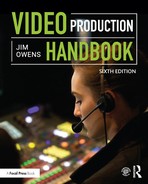Introduction
The digital revolution in television and video has changed the way we create and distribute projects. In many ways it has leveled the playing field between a recent college graduate and the CEO of a network. If your project is good, you can draw millions to it online. However, the basic production principles remain the same. In this sixth edition we continue to provide the same basic production principles while embracing the new technologies that are now around us. This book has been completely updated with the latest changes in technology and production strategies. Highlights include the following:
■ a new chapter on directing;
■ updated photographs and charts;
■ up-to-date information on new equipment and techniques;
■ new material on distribution including live to Facebook;
■ detailed teaching resources for instructors.
WHAT IS THIS BOOK ALL ABOUT?
This book was designed to provide you with the basics of video production in an easily digested format. It covers the production process and techniques involved in transforming ideas in your head into an effective presentation on a screen.
The knowledge you develop by reading this book will provide a solid foundation for video projects and future studies. We have concentrated on the practical features of video production so that you can achieve worthwhile results right from the start, whether you are using a mobile phone camera, a consumer camcorder, or professional equipment. This book will help you get the best out of your equipment. When the highest level of equipment is shown, adapt the concepts to the level you are working at.
WHO IS THIS BOOK WRITTEN FOR?
We designed this book for anyone who wants high-quality videos on a modest budget. The book was developed to help the beginner in video production learn the right way to create a video, whether in a class or working on your own. It is especially helpful for entry-level and medium-level television production courses and workshops. This text does not assume that you have any type of technical background or any previous experience—or that you are really interested in the nuts and bolts of equipment.
DO I HAVE THE RIGHT EQUIPMENT?
The equipment available today at the lowest consumer level, even some mobile phones, is good enough. The emphasis is on how to create a quality video program, and that requires knowledge of how to effectively use the equipment and how to tell a story. Today the equipment is not a big issue.
WHY IS IT IMPORTANT TO LEARN “TECHNIQUES”?
Great ideas do not automatically make great programs. It is not enough to simply show what is going on. The way you present your subject will influ ence how your audience responds. You need to know how to create quality video and audio, to convey your ideas in interesting ways to impact your audience.
TERMINOLOGY
We have tried to apply the most commonly used video production terminology in this book. However, terminology sometimes differs from country to country, and even company to company within a country. You will notice that some expressions have a term in parentheses next to them. The terms in the parentheses are usually words from the United Kingdom or Europe.
TEACHING WITH THIS BOOK
The book has been designed with numbers that refer to each topic area. This makes assigning reading areas much simpler. Instead of being limited to just page numbers, teachers can assign specific section numbers. While we have written this material in what we consider to be a logical sequence, we understand that every teacher has an order that he or she likes to use when covering the different subjects. The section numbering system allows the teacher to simply assign the material in any order.
INSTRUCTOR’S MATERIAL
We have also created instructor’s material to aid in using this book in a class room setting. Qualified instructors may access the material by contacting their Focal Press textbook representative or registering at www.focalpress.com/9780240522203.
The instructor’s material includes the following:
■ PowerPoint/Keynote slides and images that match the illustrations in the text;
■ exam questions for each chapter;
■ video demonstrations;
■ instruction recommendations.
SUMMARY
We are mainly concerned with principles and practices, since these are the timeless essentials of video productions that effectively communicate. We have updated this edition in order to help your programs have greater audience appeal and to help you with the problems you may encounter while working in video production. Keep in mind that, in the end, what really matters is what you have to say and how effective you are at saying it. Wayne Freedman, from KGO-TV, summarizes it well: “When you present your story, try to think of the television as a window or conveyance … because if you can break through the din of everything else going on … viewers are going to look, listen, and perhaps even go on a journey with you.”
Jim Owens
January, 2017
